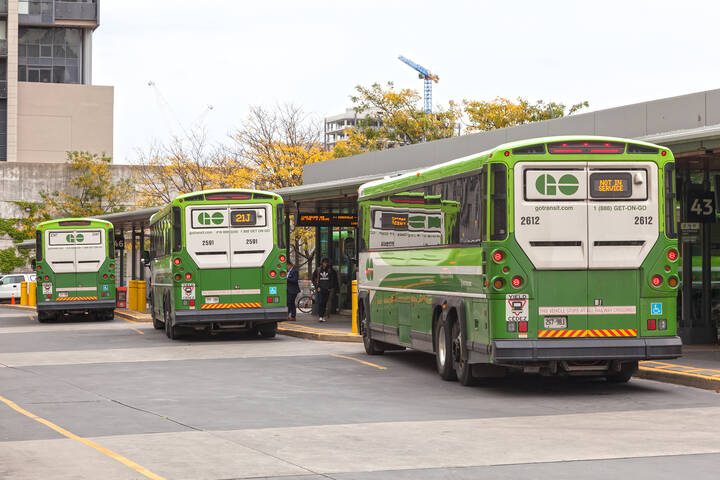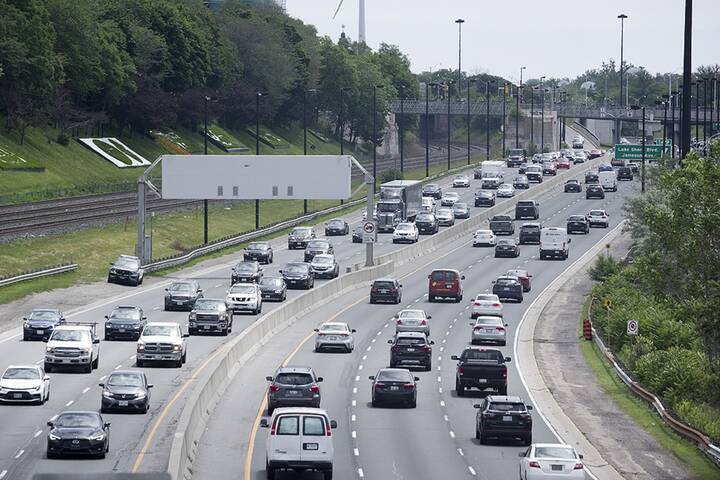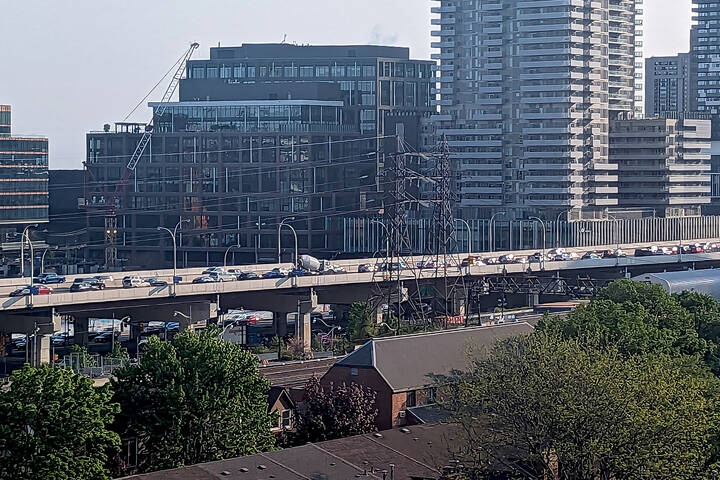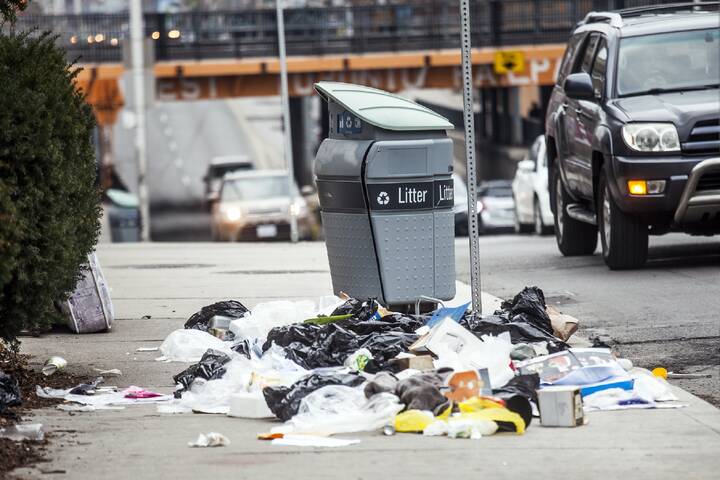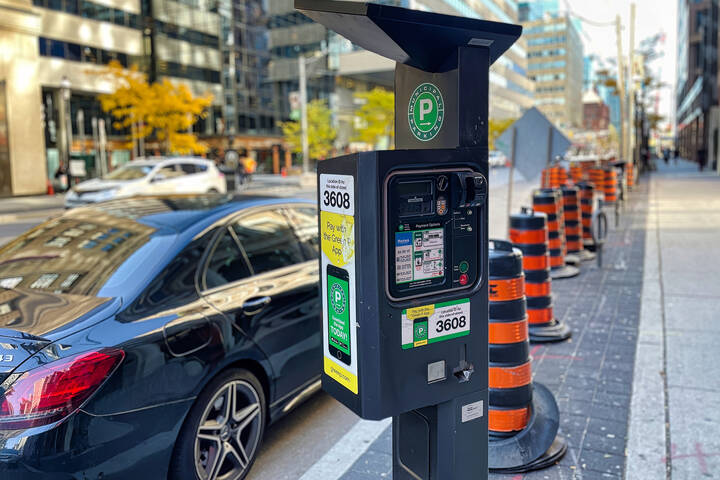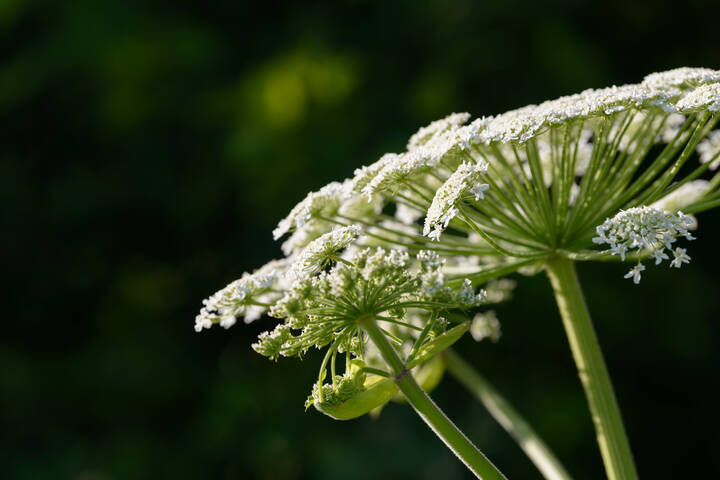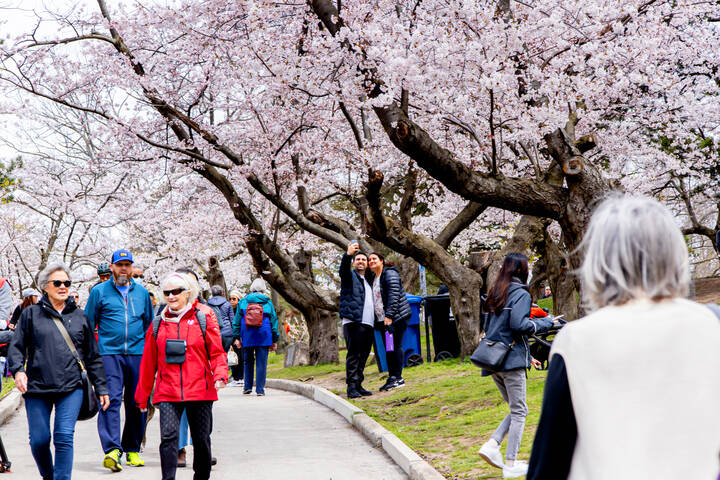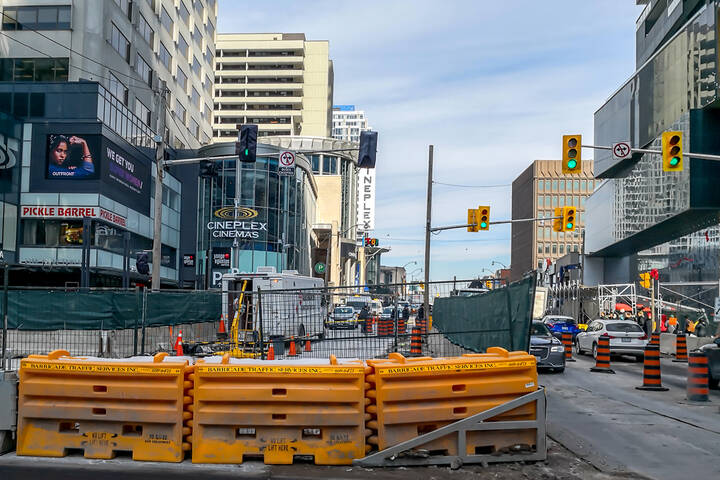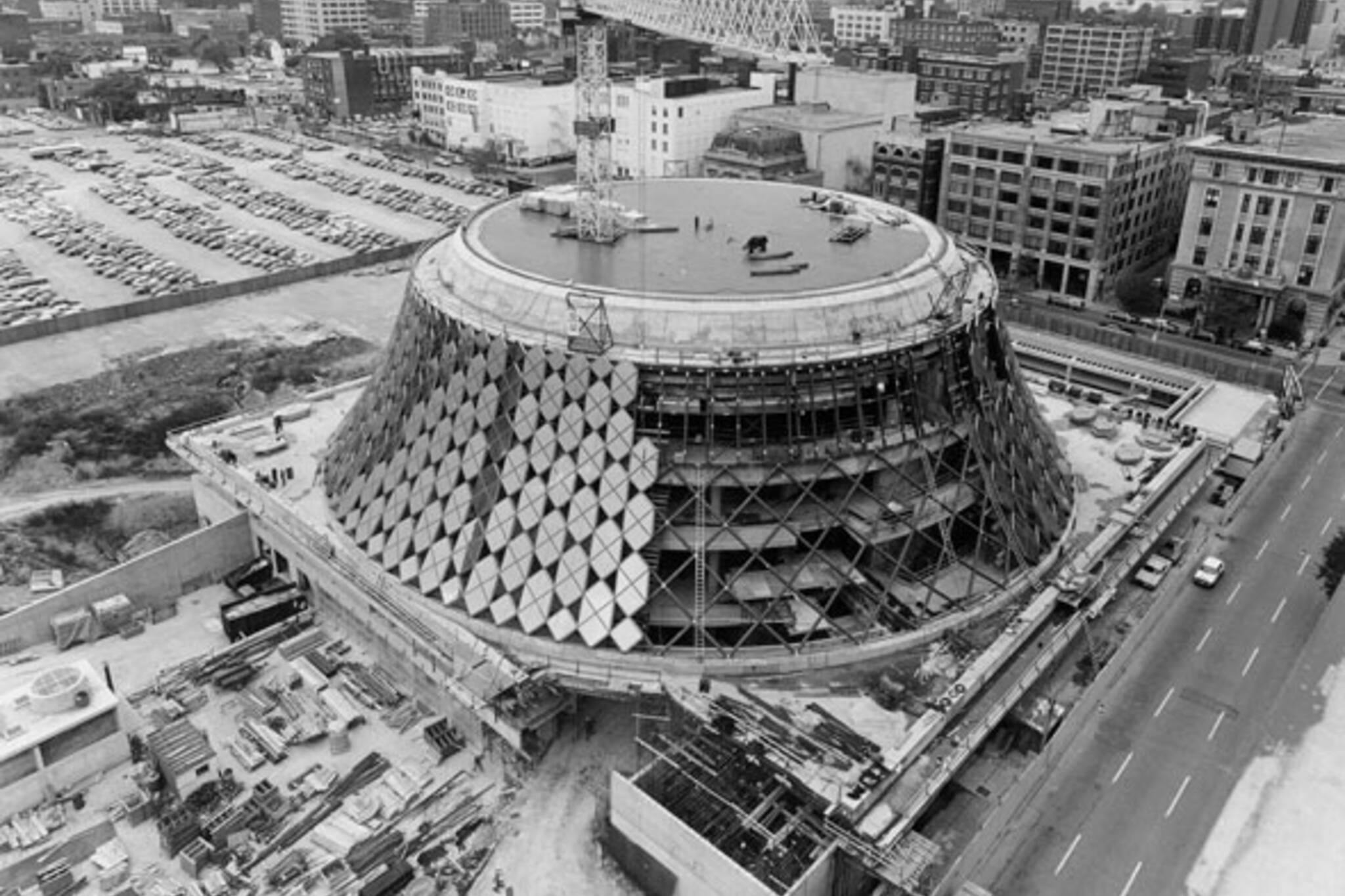
How Toronto turned a rail yard in to Roy Thomson Hall
On September 14, 1982, a small crowd of politicians and well-wishers released a thousand silver balloons in to the hazy, humid sky over downtown Toronto. As the flecks of dull colour drifted over King West, the city's new concert hall, a gleaming palace to classical music, sparkled in the late summer light. Two ends of a freshly cut ribbon fluttered in the breeze.
Designed by renowned Canadian architect Arthur Erickson, the squat little flat-topped cone - "a giant, overturned fruit bowl" - with its distinctive glass exterior had taken seven years to rise from the rubble of a former Canadian Pacific freight yard.
Toronto's new cultural centre was the sole survivor of a planned development that should have covered the entire King West block. The design of the music hall was a compromise, too. The original plans had called for something much more bold, but a lukewarm reception from construction workers had forced the plans back to basics.
Despite producing a bizarre and unsolved Toronto mystery, wrangling over the location, cost, and even the name, Roy Thomson Hall was finally ready.
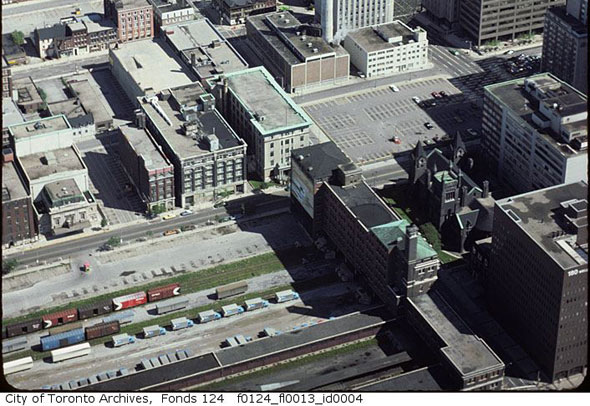
In 1975, the crowd exiting Ed Mirvish's Royal Alexandra Theatre could still gaze across King Street and see rows of Canadian Pacific and Canadian National boxcars beyond a narrow parking lot.
A relic of Toronto's industrial past, the city's extensive railway lands still crept into parts of downtown but were largely surplus to the rail needs of rail companies. Marathon Realty Corp., the real estate arm of Canadian Pacific, was charged with selling the company's share of the increasingly valuable land, which included the weed-choked tracks and overgrown loading platforms opposite the Alex.
Metro Centre, a massive plan to revitalize acres of sidings, roundhouses, and soot-stained train sheds, that suggested knocking down Union Station, extending the subway along the lake shore, and building hundreds of new offices and hotels on the disused rail lines had just fallen through, taking with it a proto-CN Tower and an early proposal for a new CBC headquarters.
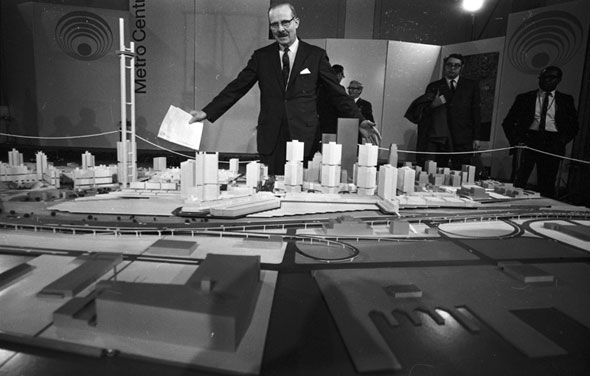
Around the time Metro Centre was failing, the board of governors in charge of Massey Hall were looking for a new concert venue to replace their aging, and often acoustically maligned, Shuter Street building.
Edward Pickering, the president of Massey Hall, called the building "appalling for musicians and artists." "The acoustics are atrocious," he told the Toronto's executive committee while pushing for a study of the rail yard site at King and Simcoe.
Pickering had his eyes on other locations as well. Massey Hall's governors were offered a new location in North York, "but to move away from the centre of the city would be a tragic mistake," he said. Eaton's had just sold a large stake in its College Street store, and the Carlu was also seen as a viable option, along with demolishing the existing Massey Hall.
However, by far the biggest hurdle facing the proposed concert hall was a new far-reaching new bylaw just passed by Mayor David Crombie's city council that required, among a raft of other rules, that all new developments over 500,000 square feet in the core of the city include a residential component.
Were it to be built at King and Simcoe, New Massey Hall would need to include 630 to 830 units of housing before it could be allowed. Marathon Realty wasn't happy - it wanted New Massey Hall to be built on its property but wanted office buildings to fill the rest of the space. A staff report urged the city to stick to its guns even if it meant killing off the development.
In an attempt to hammer out a deal, Mayor David Crombie, executive alderman Art Eggleton, and housing commissioner Michael Dennis met with Marathon Realty executives at Toronto's exclusive National Club for coffee, brandy, and fine cigars in May 1976.
The group talked until 3:00 AM and left with a verbal agreement that would deliver a new Massey Hall, a city park, a million square feet of office space, and 60,000 square feet for housing.
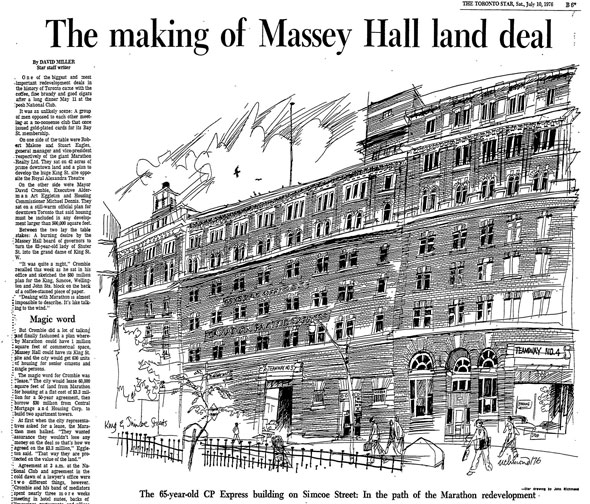
The deal was far from sealed, however. The group continued to discuss the finer details for weeks in hotel suites, limousines, restaurants. "It got so I was never sure where the next meeting would be held," Crombie told the Toronto Star. "We were going day and night there for a while."
The housing the city had so doggedly insisted on would be built, but at a $33.3 million cost to the taxpayer. Marathon would build the park and office buildings. The development would be called Downtown West.
The back room deal didn't go down well at council. A special meeting had to be adjourned when seven members walked out in protest, whipping Mayor Crombie in to a frenzy. He accused the reformers - advocates for housing component bylaw - of "abusing the legislative process."
Two meetings later, the elements of the plan were accepted by a vote of 13-9. Alderman George Ben called the agreement "the worst deal since Sir John A. Macdonald sold part of Canada to the railways for two pieces of steel."
Toronto had land for its music hall.
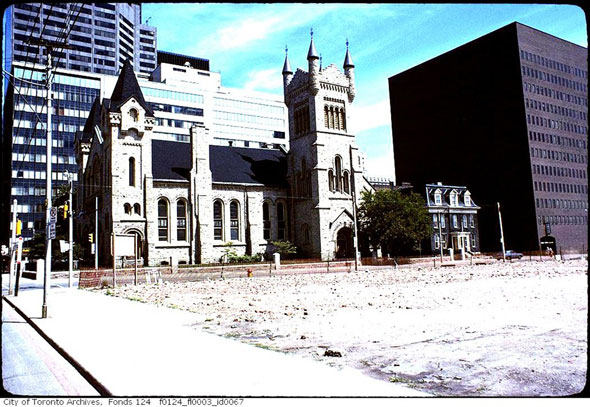
It would take a year for the lead architect Arthur Erickson to come up with his $34 million, 2,855-seater design for New Massey Hall. In the late 1970s, Erickson was one of the country's most renowned modernist designers. In Toronto, he had designed the concrete Eglinton West and Yorkdale subway stations.
Elsewhere, Erickson had created the Embassy of Canada in Washington D.C., which attracted attention after his blueprint was handpicked by personal friend Prime Minister Pierre Trudeau.
Erickson's original proposal envisioned a complex and irregular sweeping glass curtain that would fall from the roof of the concert hall like a sheet artfully draped over a top hat. It would reflect sunlight during the day and glow from within during nighttime performances by the Toronto Symphony Orchestra and Mendelssohn Choir, both residents of Massey Hall who would move into the new space.
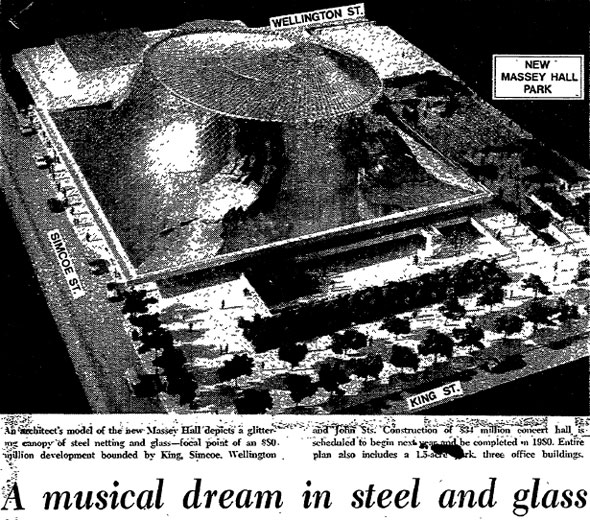
The trouble, as always, was how to pay for what would be a glittering jewel in King West's crown. From the outset, Massey Hall had offered to sell the naming rights to just about every aspect of its new auditorium: seats, boxes, foyers, and even the building itself in exchange for "any major donation."
The board needed $12.5 million to realize its concept, $5 million of which would come from the city. Through various donations and allocations of city funds the project found the capital it needed to begin construction.

Shortly after diggers turned over the first patch of soil for the foundations, the metal buckets struck an unexpected wall deep among the old foundations of a demolished CP freight office.
On further inspection, the wall was found to be part of a room roughly 10 feet square directly beneath Simcoe Street. Inside was a locked safe.
The bare room, not marked on any of the detailed plans of the old building, contained a chair, a table, and two empty cups, all of which were brought to the surface with the safe, where they quickly vanished.
The safe was roughly two-feet square, weighed "several hundred pounds," and would have been tough to steal. Nevertheless, it was never seen again, along with the odd assortment of furniture pulled from the mystery room.
"A lot of people were treating it like a piece of junk. We had planned to force it open, but it wasn't a priority," Eugene Blane, the project manager, told the Star. Also strange was the unmarked tunnel under Wellington Street that workers found during the same excavation. No-one went inside because they were scared the roof would collapse, so they just sealed it up and kept building.
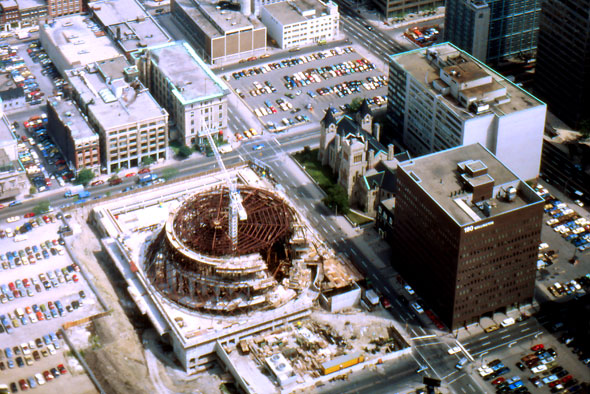
Because of the problems associated with old Massey Hall, sound design was a top priority for Erickson and his team of designers.
Dr. Ted Schultz of American sound engineering firm Bold, Beranek and Newman was hired to ensure the auditorium, which was slowly taking shape, had pitch perfect acoustics. He worked closely with expert organ maker Gabriel Kney of London, Ont. who was charged with building the instrument that would fill the hall with sound on opening night.
The massive, $523,000 organ took a team of craftsman 15,000 hours to build. Its black keys were made of ebony and its white keys from palisander wood - traditional ivory could have been poached and plastic would have made the organist's fingers sweat. The first song ever to blast from its 4,873 metal and 276 wooden pipes was a deafening rendition of Twinkle, Twinkle Little Star.
Such was the intense focus on sound quality, Schultz and Kney regularly clashed over decisions. During one particularly heated exchange, Kney objected to fixed sound deflectors being placed over his instrument and vowed to quit if they weren't made retractable (they were.)
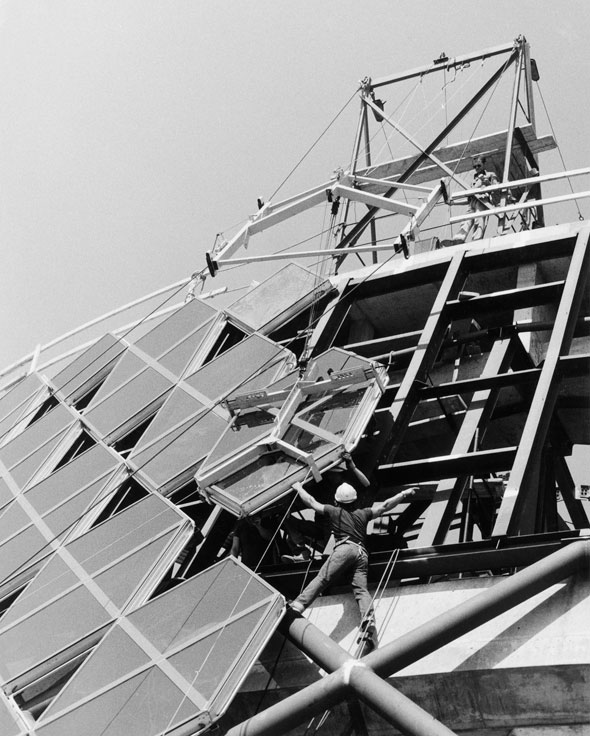
While the hall was still unofficially New Massey Hall, the Toronto Star ran an promotion that asked readers to submit ideas for a name. An early favourite was Terry Fox Hall. The cancer activist had just been forced to abandon his Marathon of Hope and had received the Order of Canada the previous September.
The name the newspaper chose, however, was Healey Willan Hall, after the late British-born symphonic, choral, and liturgical composer who lived in Toronto. Cynthia Dann-Beardsley, the reader who made the suggestion, won an all-expenses paid meal at a restaurant of her choice and two tickets for the opening performance, scheduled for September 13, 1982.
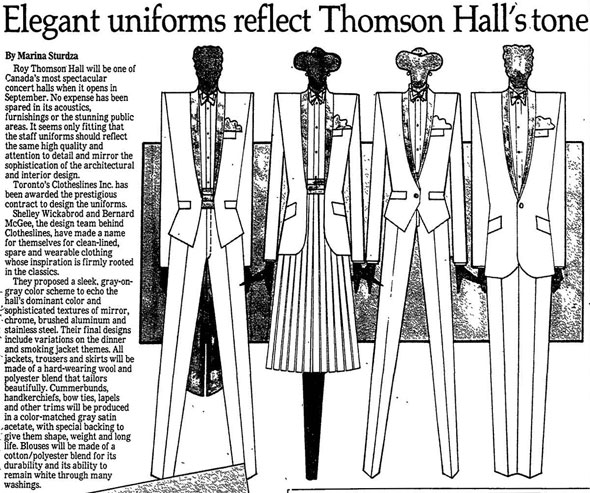
Back in the offices of the Corporation of Massey Hall, professional fundraising consultant Gord Goldie might have been leading the charge to gather the cash Massey Hall needed to complete its new venue, but Metro grandmother Judy Simmonds was certainly pulling her weight, too.
By the time the campaign finished, she had raised $1.9 million for the construction fund by selling 1,900 seat endowments to the likes of Gordon Lightfoot, Paul Anka, and Oscar Peterson. Everyone who sponsored a seat got their name engraved on a plaque that was screwed to the back for posterity.
With the money starting to flow and the building exempted from property taxes, designer Arthur Erickson was making some major revisions to his original design. The once rumpled and flowing glass roof was trimmed and constrained to a uniform shape after glass workers balked at the complex arrangement.
"It would have been like a large glass net but now we have a square and on it a circle," he said. "We couldn't get (local glass manufacturers) interested at all. It was a great disappointment." Had his original plan been realized silicon joints would have held each pane in place, giving the roof the appearance of a single sheet of glass.
It was late 1975 when the planned office and residential portions of the construction project fizzled in a land dispute between Canadian Pacific and the Ontario and Quebec Railway as each side laid claim to the western part of the block.
Seven months before New Massey Hall was due to open, the Massey Hall board announced they had decided on a name.
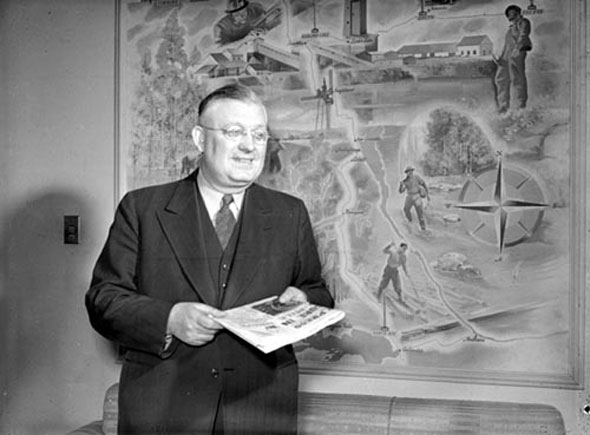
Lord Thomson of Fleet was a "feisty" self made millionaire. With $1,800 in borrowed cash, a borrowed broadcasting license, and a disused windmill for a transmission tower, Thomson started his own radio station in North Bay during the Depression. He parlayed a stake in a local newspaper and ownership of several Timmins radio stations into a media empire that in 1970 included 35 daily and 20 weekly newspapers in Canada and the United Kingdom.
He at times owned the Toronto Maple Leafs baseball team and the NHL's Los Angeles Kings. He became a baron "for public services" in 1964 and received a Knight Grand Cross of the Order of the British Empire, one of the UK's highest civilian honours, in 1970. Lord Thomson died in 1976, just as the the city decided on the King Street West site for its new music hall.
Thomson's family, the current majority owners of the Globe and Mail, donated $4.5 million to the New Massey Hall fund in memory of their patriarch, in doing so became the highest private bidder for the naming rights to the building. The decision to title the hall after a rich media mogul who once declared "the most beautiful music to my ears was a spot commercial at 10 bucks a whack" prompted a public outcry and drew the attention of city council.
A group of councillors wanted the building renamed Toronto Concert Hall in honour of the $27.7 million of public funds spent on its planning and construction, but it didn't work. The Thomson family motto that adorns its coat of arms reads "never a backward step," and the name stayed. One letter writer called the name a "disgusting obscenity."
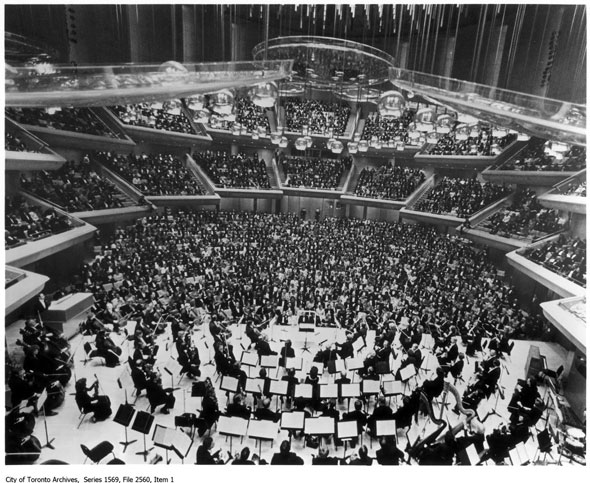
Roy Thomson Hall opened late and $5 million over budget on September 13, 1982, but its presence was already being felt on King West. New restaurants had already opened close by, transforming the lonely post-industrial neighbourhood into a bustling evening destination.
Ed Mirvish snapped up several properties on the north side of King almost to John Street for new restaurants and a nightclub. "It's going to be very exciting down here," the theatrical impresario beamed. Joe Allen, an offshoot of a restaurant popular New York eatery, La Cantinetta, La Pigalle, The Pork Place, Julien, and Metz all opened up close by too.
"We wanted to be near the Royal Alex and the new Massey Hall," said Joe Allen owner John Maxwell said a few months before his kitchen opened.
300 local worthies turned out for the opening ceremony, including Premier William Davis and Mayor Art Eggleton. A brass band in suits and tails played Beethoven's 5th as the ribbon was cut. "Roy Thomson Hall represents a triumph of the doers over the naysayers," Eggleton announced in to the microphone. Davis called it "an asset not just for Toronto but all of Canada."
He urged people to keep buying the Wintario lotto tickets that had provided $10 million for Roy Thomson Hall's construction. "There [is still] the convention centre, the domed stadium, etc" left to build.
"Roy Thomson Hall: A Portrait," a new book by William Littler and John Terauds, published by Dundurn, is out now.
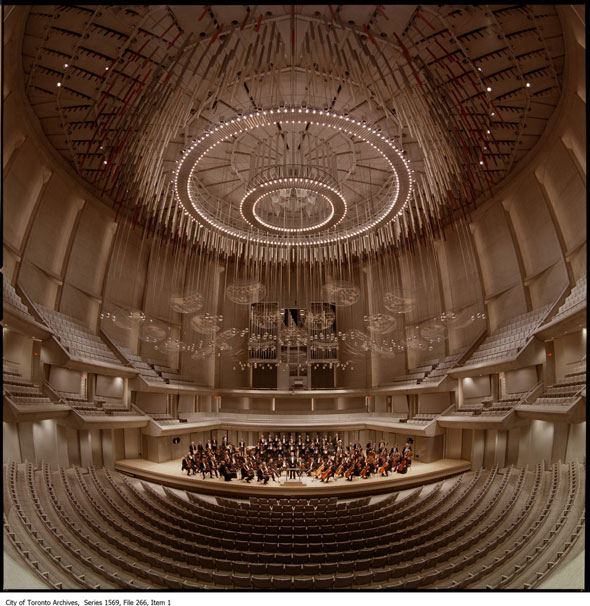
Chris Bateman is a staff writer at blogTO. Follow him on Twitter at @chrisbateman.
Image: The Corporation of Massey Hall & Roy Thomson Hall Archives, City of Toronto Archives, Toronto Public Library, Toronto Star
Latest Videos
Latest Videos
Join the conversation Load comments
